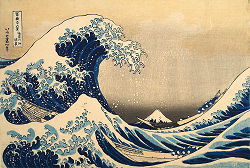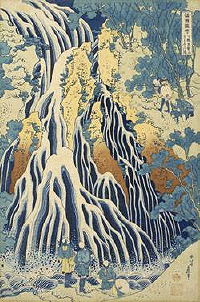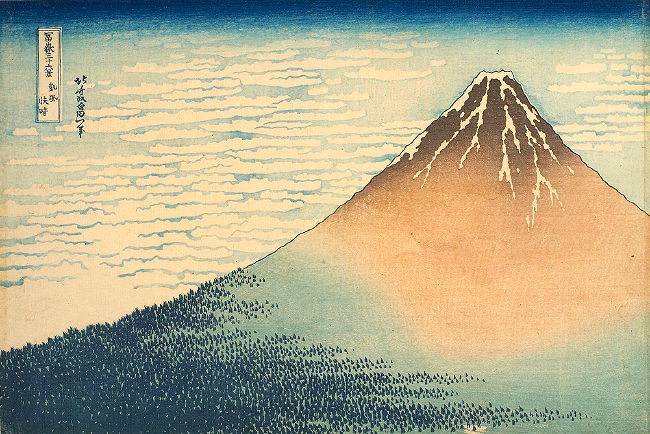Hokusai was a multifaceted artist and had an extravagant personality. He was also an audacious creator who changed signatures some fifty times and left a large, rich and varied work. The most famous in the Western world is undoubtedly The breaking wave off Kanagawa. It is among the nearly forty works (paintings, prints and drawings) exceptionally presented to the public for three months.
 Thirty six views of Mount Fuji (Fugaku sanjûrokkei), The breaking wave off Kanagawa (the great wave) (Kanagawa oki namiura), 1830-32, multi colored print (nishiki-e), ôban format. Publication: Eijudô. Signature: Hokusai aratame Iitsu hitsu. Legacy Raymond Koechlin, 1932. EO 3285 © Thierry Ollivier/RMN
This major work mentioned earlier introduces the series of 46 prints dedicated to Mount Fuji which Katsushika Hokusai (1760-1849), painter, drawer, printer and author of technical and aesthetic treaties created. The prints were published between 1831 and 1833, and present Mount Fuji from different angles, according to the seasons. This series 36 views of Fuji, done in large format, totally dedicated to the landscape and of which the central theme illustrates the relationship between man and nature, was to revolutionize the art of printing in the nineteenth century. Five of these views are presented in the exhibition. Hokusai grasps a very brief natural phenomenon. The representation of an instant, a moment, of a fleeing impression is typical of the ukiyo-e, “images of an ephemeral and floating world ”. This print translates the literal and metaphoric vision unveiled by the dynamism of his composition: the precise instant when the wave threatens to crush the boats and swallow the vulnerable fishermen whose fragile existence–a parable of humanity- is dependent on Nature’s whims.
A model for the West
Everyone and everything are subject to the wave, mostly due to its aesthetics. Hokusai introduced the European techniques of the perspective to translate spatial depth. The wave appears in the forefront, while the volcano is a tiny witness to a scene in which the fishermen risk their lives in the raging sea. The silhouette of the latter, fragmented at the top into a multitude of small waves, similar to the claws of threatening dragons, transmits the artist’s creative energy … Hokusai’s work was definitely innovating, and was also a very important source of inspiration for Western painters afflicted by “Japonaiserie” in the XIXth century. Many of them, whether Van Gogh, Monet, Degas, Renoir, Pissaro or Klimt, even collected his prints. He influenced various poets and musicians as can be seen in The breaking wave off Kanagawa which was one of Debussy’s greatest sources of inspiration when he composed La Mer.
 A tour of the waterfalls of the various Provinces The Kirifuri cascade on Mount Kurokami in the Shimotsuke Province (Shimotsuke Kurokamiyama Kirifuri no taki) 1833. Polychrome printing (nishiki-e), ôban format. Publisher Eijudô Signature: zen Hokusai Iitsu hitsu. Norbert Lagane donation, 2001 MA 12179 © Thierry Ollivier / RMN
Another work of the great artist, Warrior on a rearing horse , dated circa 1830, is part of universal graphic masterpieces; the sketch, well executed in India ink on fine lined paper, brings together the intense energy of the paintbrush and the minute, patient quest for a rare, formal precision. The work is proof of the artist’s precise visual performance and his exceptional talent as a drawer. It is part of an ensemble of rare sketches and preparatory drawings kept at the Guimet museum, some of them originally in the older Parisian collections. Ever since the large retrospective the musée Guimet had dedicated to HOKUSAI, “l’affolé de son art” (desperate of his art) from Edmond de Goncourt to Norbert Lagane, presented from 21 May to 4 August 2008, these rare and precious works had been returned to the funds due to their great fragility and their being loaned to other museums.
| 









